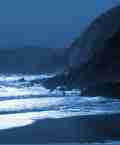 |
Search the site:

Grey SealHalichoerus grypus Rón glas This seal is known also as the Atlantic seal, its range corresponding roughly with the north-western seaboard of the Atlantic. In Ireland it ranges along all the coasts but its main habitats and breeding areas lie on the western, northern and parts of the southern coasts where it is largely replaced by the Common seal. Grey seals are in general more 'commonplace' than Common seals, preferring rocky wave-pounded coasts to the calmer inshore waters favoured by the latter animal. Breeding occurs on rocky inlets and uninhabited islands in the autumn, a year after the bulls have established territories and mated with the cows. A single pup is born to the cow, and this is nurtured throughout the winter by the female. For the first month the pup remains on the land. Grey seals are among the most attractive of young animals, with their beautifully silky white fur, large appealing eyes and general attitude of helplessness. The bull Grey seal is generally dark grey above, paler beneath and irregularly blotched with black. Colour and pattern varies though, and they may look very dark all over in certain circumstances. Females (cows) are generally paler, particularly underneath. Bulls are massive, up to 9ft (3m) or more in length and weighing 500lb (227kg). The cows are a couple of feet shorter and only half the weight of the male. A wide variety of marine food is eaten, ranging from crustaceans like crab and lobster to shellfish and squid, salmon and other fish. Conflict between fishermen and seals is not new, as they compete for some of the same catch. This has resulted in some illegal 'culling' of seal numbers. Ireland has a special responsibility towards the well-being of Grey seal colonies, with half the European population found around the country's coast.
The 'Common', or Harbour seal, as it is also known, is mainly an inshore animal, frequenting inlets, estuaries and unpolluted harbours. This seal is less numerous than the Grey seal over much of the western and northern coastlines. There is considerable variation in the colour and pattern in this sealís coat. The adult has predominantly greyish to greyish-brown upper parts, with irregular black mottling. This mottling is repeated on the underside, which is lighter, silver or cream. The young have a darker, greyish brown mottled coat. Old bulls may reach 6ft (2m) long and weigh 550lb (250kg), while females generally reach 5ft and weigh 330lb (150kg). The common seal shares much of the Grey sealís diet, but is an opportunist, eating a wide variety of inshore and estuarine fish species. Irish seals are essentially salt-water animals but the Common seal may be seen occasionally in brackish water or sometimes even on larger rivers, miles from the sea.
This detail is taken from the Appletree title Animals of Ireland by Gordon D'Arcy. Full colour illustrations throughout. |
[ Back to Top ]
All Material © 1999-2004 Irelandseye.com and contributors
